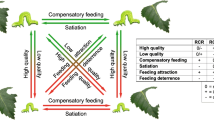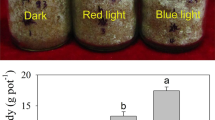Abstract
Perfluorooctane sulfonate (PFOS) which has been distributed worldwide is a persistent organic contaminant. Blueberry anthocyanins (ANT) are phytonutrients with antioxidant activities. The influence of different PFOS and ANT concentrations on the behavioral activities, regeneration of planarians (Dugesia japonica), and the expression levels and contents of Djnad6 and Djcox1 genes has been investigated. PFOS treatments affected the gene expression levels, induced a decrease in the planarians’ locomotor velocity, and increased the time required for the regeneration of the transverse amputated fragments in a time- and dose-dependent manner. Additionally, ANT treatments, to a certain extent, alleviated the damage caused by PFOS to planarians. ANT increased the planarians’ locomotor velocity and the percentage of regenerating planarians with eyespots and auricles. Furthermore, ANT alleviated the expression disorders of Djnad6 and Djcox1 induced by PFOS.








Similar content being viewed by others
References
Alonso A, Camargo JA (2011) The freshwater planarian Polycelis felina as a sensitive species to assess the long-term toxicity of ammonia. Chemosphere 84(5):533–537
Andres-Lacueva C, Shukitt-Hale B, Galli RL, Jauregui O, Lamuela-Raventos RM, Joseph JA (2005) Anthocyanins in aged blueberry-fed rats are found centrally and may enhance memory. Nutr Neurosci 8(2):111–120
Boulanger B, Peck AM, Schnoor JL, Hornbuckle KC (2005) Mass budget of perfluorooctane surfactant in Lake Ontario. Environ Sci Technol 39(1):74–79
Borges G, Degeneve A, Mullen W, Crozier A (2010) Identification of flavonoid and phenolic antioxidants in black currants, blueberries, raspberries, red currants, and cranberries. J Agric Food Chem 58(7):3901–3909
Burdulis D, Sarkinas A, Jasutiené I, Stackevicené E, Nikolajevas L, Janulis V (2009) Comparative study of anthocyanin composition, antimicrobial and antioxidant activity in bilberry (Vaccinium myrtillus L.) and blueberry (Vaccinium corymbosum L.) fruits. Acta Pol Pharm 66(4):399–408
Chen L, Xin X, Yuan Q, Su D, Liu W (2014) Phytochemical properties and antioxidant capacities of various colored berries. J Sci Food Agric 94(2):180–188
Fei C, McLaughlin JK, Tarone RE, Olsen J (2008) Fetal growth indicators and perfluorinated chemicals: a study in the Danish national birth cohort. Am J Epidemiol 168(1):66–72
Gerhardt A, Janssens De Bisthoven L, Soares AM (2004) Macroinvertebrate response to acid mine drainage: community metrics and on-line behavioural toxicity bioassay. Environ Pollut 30(2):263–274
Giesy JP, Kannan K (2001) Global distribution of perfluorooctane sulfonate in wildlife. Environ Sci Technol 35(7):1339–1342
González-Estévez C, Felix DA, Aboobaker AA, Saló E (2007) Gtdap-1 and the role of autophagy during planarian regeneration and starvation. Autophagy 3(6):640–642
Hafeez BB, Siddiqui IA, Asim M, Malik A, Afaq F, Adhami VM, Saleem M, Din M, Mukhtar H (2008) A dietary anthocyanidin delphinidin induces apoptosis of human prostate cancer PC3 cells in vitro and in vivo: involvement of nuclear factor-kappa B signaling. Cancer Res 68(20):8564–8572
Hanson N, Stark JD (2012) Utility of population models to reduce uncertainty and increase value relevance in ecological risk assessments of pesticides: an example based on acute mortality data for daphnids. Integr Environ Assess Manag 8(2):262–270
Huang Y, Cartlidge R, Walpitagama M, Kaslin J, Campana O, Wlodkowic D (2018) Unsuitable use of DMSO for assessing behavioral endpoints in aquatic model species. Sci Total Environ 615:107–114
Irons TD, Kelly PE, Hunter DL, Macphail RC, Padilla S (2013) Acute administration of dopaminergic drugs has differential effects on locomotion in larval zebrafish. Pharmacol Biochem Behav 103(4):792–813
Irving EC, Baird DJ, Culp JM (2003) Ecotoxicological responses of the mayfly Baetis tricaudatus to dietary and waterborne cadmium: implications for toxicity testing. Environ Toxicol Chem 22(5):1058–1064
Karlsen A, Paur I, Bøhn SK, Sakhi AK, Borge GI, Serafini M, Erlund I, Laake P, Tonstad S, Blomhoff R (2010) Bilberry juice modulates plasma concentration of NF-kappa B related inflammatory markers in subjects at increased risk of CVD. Eur J Nutr 49(6):345–355
Knakievicz T, Ferreira HB (2008) Evaluation of copper effects upon Girardia tigrina freshwater planarians based on a set of biomarkers. Chemosphere 71(3):419–428
Lee S, Kim S, Park J, Kim HJ, Choi G, Choi S, Kim S, Kim SY, Kim S, Choi K, Moon HB (2018) Perfluoroalkyl substances (PFASs) in breast milk from Korea: time-course trends, influencing factors, and infant exposure. Sci Total Environ 612:286–292
McWilliam RA, Baird DJ (2002) Application of postexposure feeding depression bioassays with Daphnia magna for assessment of toxic e uents in rivers. Environ Toxicol Chem 21(7):1462–1468
Olsen AJ, Nordtug T, Altin D, Lervik M, Hansen BH (2013) Effects of dispersed oil on reproduction in the cold water copepod Calanus finmarchicus (Gunnerus). Environ Toxicol Chem 32(9):2045–2055
Paul AG, Jones KC, Sweetman AJ (2009) A first global production, emission, and environmental inventory for perfluorooctane sulfonate. Environ Sci Technol 43(2):386–392
Raffa RB, Valdez JM (2001) Cocaine withdrawal in Planaria. Eur J Pharmacol 430(1):143–145
Raffa RB, Holland LJ, Schulingkamp RJ (2001) Quantitative assessment of dopamine D2 antagonist activity using invertebrate (Planaria) locomotion as a functional endpoint. J Pharmacol Toxicol Methods 45(3):223–226
Ramakrishnan L, Amatya C, DeSaer CJ, Dalhoff Z, Eggerichs MR (2014) Galantamine reverses scopolamine-induced behavioral alterations in Dugesia tigrina. Invertebr Neurosci 14(2):91–101
Ross KG, Currie KW, Pearson BJ, Zayas RM (2017) Nervous system development and regeneration in freshwater planarians. WIREs Dev Biol 6(3):e266
Sato I, Kawamoto K, Nishikawa Y, Tsuda S, Yoshida M, Yaegashi K, Saito N, Liu W, Jin Y (2009) Neurotoxicity of perfluorooctane sulfonate (PFOS) in rats and mice after single oral exposure. J Toxicol Sci 34(5):569–574
Starkov AA, Wallace KB (2002) Structural determinants of fluorochemical-induced mitochondrial dysfunction. Toxicol Sci 66(2):244–252
Sun J (2010) Molecular synthetics of Dugesia japonica in He Nan and Yun Nan provinces based on CO1 sequences. Dissertation, Henan normal university
Tatum-Gibbs K, Wambaugh JF, Das KP, Zehr RD, Strynar MJ, Lindstrom AB, Delinsky A, Lau C (2011) Comparative pharmacokinetics of perfluorononanoic acid in rat and mouse. Toxicology 281:48–55
Watts MM, Pascoe D, Carroll K (2001) Survival and precopulatory behaviour of Gammarus pulex (L.) exposed to two xenoestrogens. Water Res 35(10):2347–2352
Yan L, Zhang ZF, Park JC, Kim IH (2012) Evaluation of Houttuynia cordata and Taraxacum o cinale on growth performance, nutrient digestibility, blood characteristics, and fecal microbial shedding in diet for weaning pigs. Asian Australas J Anim Sci 25(10):1439–1444
Yuan ZQ, Miao ZL, Gong XN, Zhao BY, Zhang YY, Ma HD, Zhang JY, Zhao BS (2017) Changes on lipid peroxidation, enzymatic activities and gene expression in planarian (Dugesia japonica) following exposure to perfluorooctanoic acid. Ecotoxicol Environ Saf 145:564–568
Yuan ZQ, Zhang JY, Meng W, Zhou Y (2014) Effects of perfluorooctane sulfonate on behavioural activity, regeneration and antioxidant enzymes in planarian Dugesia japonica. Chem Ecol 30(2):187–195
Zhang JY, Yuan ZQ, Zheng MY, Sun YQ, Wang YJ, Yang SD (2013a) Effects of N,N-dimethylformamide on behavior and regeneration of planarian Dugesia japonica. Toxicol Ind Health 29(8):753–760
Zhang YH, Wang J, Dong GH, Liu MM, Wang D, Zheng L, Jin YH (2013b) Mechanism of perfluorooctanesulfonate (PFOS)-induced apoptosis in the immunocyte. J Immunotoxicol 10(1):49–58
Funding
This study was funded by the National Natural Science Foundation of China (grant number 31100377 and 41201518), Project of Shandong Province Higher Educational Science and Technology Program (grant number J16LE02), and a SDUT & Zibo City Integration Development Project (grant number 2017ZBXC053).
Author information
Authors and Affiliations
Corresponding author
Ethics declarations
Conflict of interest
The authors declare that they have no conflict of interest.
Additional information
Responsible editor: Philippe Garrigues
Rights and permissions
About this article
Cite this article
Zhao, B., Shao, X., Zhao, B. et al. Application of blueberry anthocyanins reduces perfluorooctane sulfonate toxicity on planarians (Dugesia japonica) in locomotion, regeneration, and gene expression and contents. Environ Sci Pollut Res 25, 22095–22105 (2018). https://doi.org/10.1007/s11356-018-2127-7
Received:
Accepted:
Published:
Issue Date:
DOI: https://doi.org/10.1007/s11356-018-2127-7




